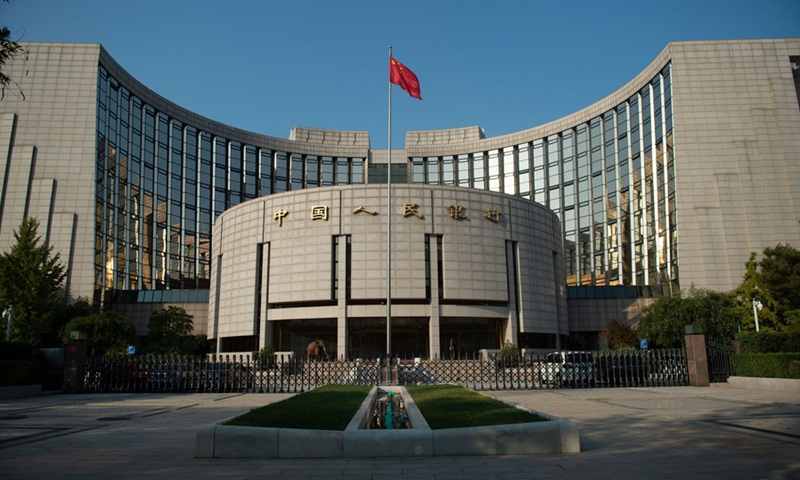
Photo shows an exterior view of the People's Bank of China in Beijing. Photo: Xinhua
China's central bank on Monday added 995 billion yuan ($138.84 billion) worth of one-year medium-term lending facility (MLF) loans to some financial institutions, but kept the policy rate unchanged. Although it was beyond market expectations, analysts said reserve requirement ratio (RRR) and interest rate cuts and other structural tools remain in the central bank's toolkit to ensure a sustained economic recovery in 2024.
In order to maintain reasonable and ample liquidity in the banking system, the People's Bank of China (PBC) conducted 89 billion yuan of seven-day reverse repos at an interest rate of 1.8 percent.
In addition, a total of 995 billion yuan was injected into the market via the MLF, which will mature in one year at an interest rate of 2.5 percent, unchanged from the previous operation, according to a statement on the central bank's website on Monday.
The central bank's move was slightly beyond market expectations, but will be conducive to flexible and prudent monetary policy amid the growing external challenges of macro-policy uncertainties and geopolitical tensions, Zhou Maohua, a macroeconomic analyst at Everbright Bank, told the Global Times on Monday.
China's economy has extended its recovery, and new loans grew by an appropriate amount in 2023, which showed that market interest rates are in a reasonable range, Zhou said.
China's yuan-denominated loans rose by 22.75 trillion yuan in 2023, a year-on-year increase of 1.31 trillion yuan, according to data released by the PBC on Friday.
"With added liquidity in the banking system, the central bank aims to guide financial institutions to step up support for weak economic links and key sectors, which will bolster market confidence in the economic recovery," he said.
RRR and interest rate cuts and other structural tools are still possible options in 2024, Zhou said, noting that more policies are needed to release domestic demand and bolster the real economy.
The tone-setting Central Economic Work Conference held in Beijing in December 2023 said that prudent monetary policy should be flexible, moderate, precise and effective, pointing to a "reasonable and sufficient" liquidity level that matches the growth of social financing and money supply with the expected targets for economic growth and price levels.
Yang Delong, chief economist at Shenzhen-based First Seafront Fund Management Co, told the Global Times on Monday that China's monetary policy will remain relatively relaxed in 2024 so as to maintain low interest rates, ample liquidity and credit growth to support the development of enterprises, especially the private sector.
As existing policies continue to produce effects and new policies are released, consumption, investment and exports will gradually recover, bringing annual GDP growth to about 5 percent in 2024, Yang said, noting that the central government is expected to announce more policies to resolve risks in real estate, local government debt and smaller financial institutions this year.
Zhou said the central bank is likely to keep the one-year loan prime rate (LPR) unchanged on January 20, as the LPR often mirrors the one-year MLF rate.
Yang said the authorities have many tools to drive the sustainable development of the Chinese economy in 2024. "In 2023, the budget deficit ratio was lifted to about 3.8 percent through the issuance of an additional 1 trillion yuan worth of government bonds in the fourth quarter. The figure is expected to exceed 3 percent again this year to stimulate domestic demand, bolster market confidence and support growth," he said.




